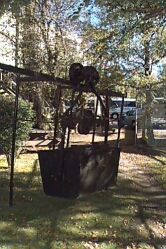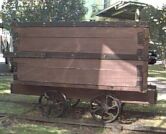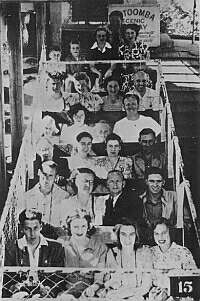|
The world famous Katoomba Scenic Railway was originally part of a
network of tramlines built to bring coal and kerosene shale from mines up to the main
railway.
John Britty North registered "Katoomba Coal Mine" in
1872. In 1882, a loading platform called North's Siding was opened near Gundar St, and a
network of tramways developed from there. These included what is now the Scenic Railway.
Locating kerosene shale at Ruined
Castle, he registered "Katoomba Coal & Shale Co. Ltd" in 1885. German
engineers were hired to construct an aerial ropeway. Known as the "Flying Fox",
it ran from the Ruined Castle, across the Jamison Valley, to the engine bank (near the
upper terminus of the Scenic Railway). It collapsed after only a six months, the wreckage
is still strewn across the valley. The company soon went into liquidation.
The Australian Kerosene Oil & Mineral Company took over the
Glen Shale Mine in the Megalong Valley &, soon after, the Ruined Castle mines. They
decided to concentrate their efforts on the Glen Shale Mine. A sizeable miners settlement
sprang up in Nellies Glen with general store, bakery, butchery & public Hall.
|

Shale bucket from the ill-fated aerial ropeway.

Coal skip used on the tramway.
Photos © 2000 D. Martin
|
|
|
A miners track, now the Golden Stairs, ascended the eastern side
of Narrow Neck from where a track of sorts led into Katoomba. Another precipitous
descent, Dixon's Ladder, led down to the Nellies Glen hotel.
By 1895 both mines were winding down, & Katoomba's shale oil
industry was abandoned by 1903.
In 1925, the Katoomba Colliery was registered, with the aim of
re-opening the coal mine at the base of the cliffs. Coal was to be sold to the Katoomba
Electric Power-house, and to hotels, residents etc. They set about rehabilitating the
cable-haulage way from the cliff-top to the valley below; this would later become the
Scenic Railway.
The first passengers, a group of weary bushwalkers, were carried
in a coal wagon, in the late 1920's. Management realised the financial potential, and had
seats built onto some coal skips.
The Depression, & the closure of the Katoomba Electric
Power-house, spelt the death of the coal mine. From about 1933, the company concentrated
on the tourist trade, constructing a passenger car called Mountain Devil.
|
|
|
|
The first public passengers, a group of weary bushwalkers, were carried
up in the late 1920's. Empty chaff sacks provided a soft and clean place to
kneel inside the coal skips. Management realised the financial potential, and had
seats built onto some coal skips.
The Depression, & the closure of the Katoomba Electric
Power-house, spelt the death of the coal mine. From about 1933, the company concentrated
on the tourist trade, constructing a passenger car called "The Mountain
Devil" (photo, right). The person perched on the rear is
probably Fred Gull, the mine blacksmith, who served as tour guide.
Photo A. Manning, 1936.
Jim Smith Collection
|

|
|
| Following the mining company's liquidation after World War 2,
the part of the operation associated with the cliff railway was purchased by
Mr Harry Hammon, the only person to submit a tender. It was the late Harry
Hammon, & his son Phillip, who turned the steam driven mining incline into today's computer-controlled tourist railway.
Ready to take the plunge!
Photo: unknown, late 1940's.
Evidently one of a set of souvenir photos. |
 |
|
